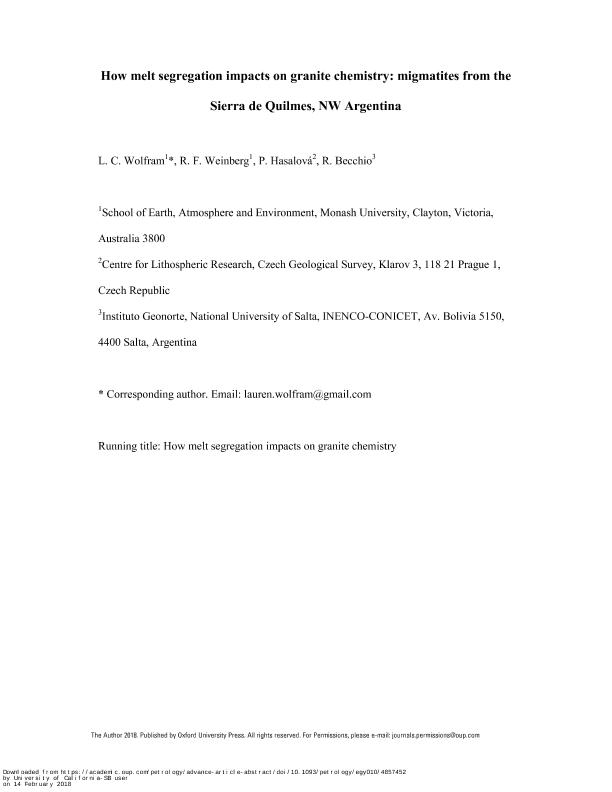Artículo
How melt segregation affects granite chemistry: Migmatites from the Sierra de Quilmes, NW Argentina
Fecha de publicación:
12/2017
Editorial:
Oxford University Press
Revista:
Journal Of Petrology
ISSN:
0022-3530
Idioma:
Inglés
Tipo de recurso:
Artículo publicado
Clasificación temática:
Resumen
Compositional variability of crustal-derived granites has been attributed to a multitude of processes. Although there has been much discussion on the entrainment of residuum and its effect on granite magma chemistry, the exact nature of what is entrained and when entrainment is efficient remain unclear. We describe the relationship between granulite-facies migmatites and granites in the Sierra de Quilmes, NW Argentina, focusing on how the style of melt segregation affects its ability to disaggregate the source and carry residual minerals, and therefore control granite chemistry. The north-south-trending mountains that define the region known as the Sierras Pampeanas are characterized by variably metamorphosed turbidites of the Neoproterozoic-Cambrian Puncoviscana Formation. Early Ordovician subduction on the western Gondwana margin produced widespread high-T, low-P metamorphism of the turbidites during the Famatinian orogeny (~500- 440 Ma), resulting in extensive anatexis and granite plutonism. The Tolombón complex of the northern Sierra de Quilmes is a tilted metamorphic sequence in the northern Sierras Pampeanas, providing near-complete exposure from granulite-facies magma source rocks in the SW to granite emplacement levels in amphibolite- and greenschist-facies rocks in the NE. Anatexis is associated with fluid-absent incongruent breakdown of biotite in granulite-facies rocks, evidenced by the presence of peritectic Grt±Crd±Opx. The western Tolombón complex is separated from the Ovejeria complex by a shear zone. The Ovejeria complex is distinguished by a generally higher melt fraction, and is dominated by gradational contacts from metatexites to diatexites and granites. In contrast, in the Tolombón complex, with few examples of diatexites, magmas are more commonly extracted from metatexites, and migrate to feed stocks and plutons at higher crustal levels. Granites derived from diatexites tend to remain close to the source and retain strong compositional similarities to the Puncoviscana Formation protolith, indicating significant mobilization of residuum, and defining the Ovejeria style of granite formation. Granites derived dominantly from melt extraction from metatexites tend to be leucogranites with compositions approaching those of experimental melts, defining the Tolombón style of granite formation. Magma derived through either mechanism undergoes further differentiation, giving rise to the compositionally diverse suite of rocks common to most anatectic terranes. Magmas derived through the Tolombón style of melt extraction are leucocratic and impoverished in light rare earth elements (LREE), Th, and Zr compared with both the sedimentary source rocks and residuum-rich magmas derived through the Ovejeria style of granite formation. The low solubility of zircon and monazite in relatively dry, peraluminous leucogranite melts guarantees that Zr, Th, and LREE behave as compatible elements during dehydration melting of metasedimentary packages. Therefore, neither style of granite formation contributed to the transfer of many of the typical trace elements enriched in the upper crust. Instead, biotite dehydration melting in the Sierra de Quilmes had the opposite effect of typical crustal differentiation, concentrating these trace elements in the residual source, possibly reflecting the lack of a pressure gradient driving extraction of residuum-rich magmas.
Archivos asociados
Licencia
Identificadores
Colecciones
Articulos(SEDE CENTRAL)
Articulos de SEDE CENTRAL
Articulos de SEDE CENTRAL
Citación
Wolfram, L. C.; Weinberg, Roberto F.; Hasalová, Pavlína; Becchio, Raul Alberto; How melt segregation affects granite chemistry: Migmatites from the Sierra de Quilmes, NW Argentina; Oxford University Press; Journal Of Petrology; 58; 12; 12-2017; 2339-2364
Compartir
Altmétricas




